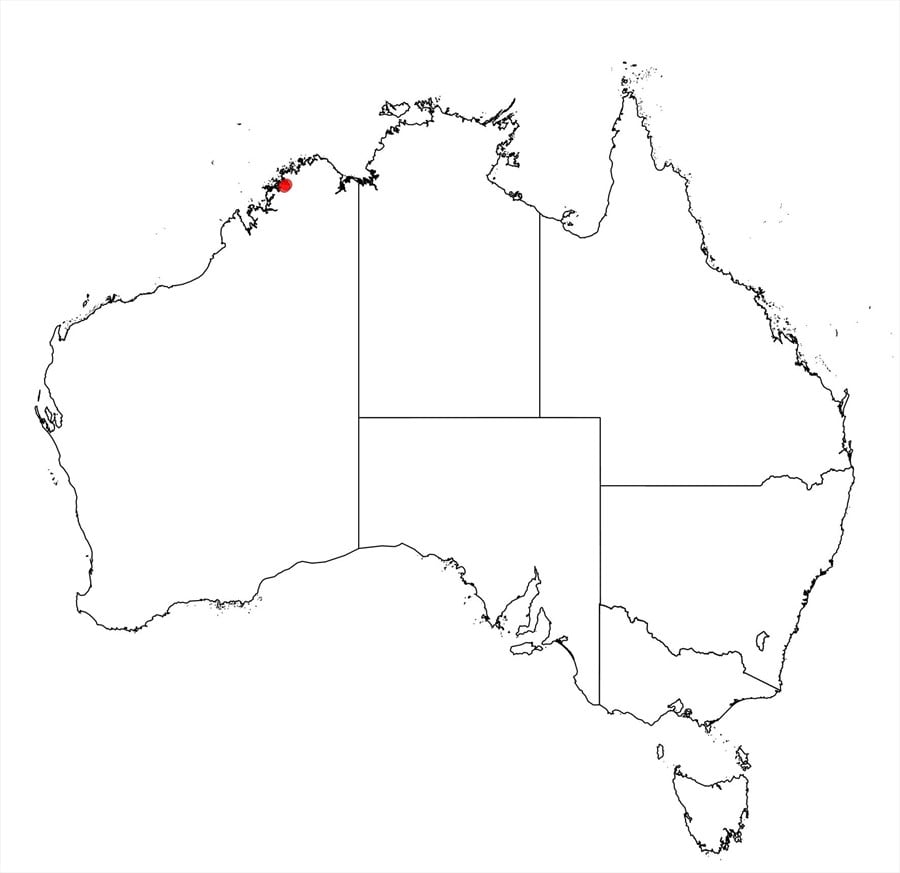Acacia synantha Maslin, M.D.Barrett & R.L.Barrett
WATTLE
Acacias of Australia
Common Name
Sandstone Synchronous Wattle
Family
Fabaceae
Distribution
Occurs in the W Kimberley region of northern Western Australia where it is known from only three populations over a distance of c. 20 km in the northern Prince Regent Natl Park.
Description
Erect, glabrous shrub c. 1.5 m tall. Branchlets angled to ±flattened at extremities but aging terete, brownish grey, resin-ribbed. Phyllodes elliptic or sometimes ovate-elliptic, dimidiate with lower margin straight or shallowly convex and upper margin clearly convex, (3–) 3.5–7 cm long, 10–25 mm wide, l: w = 3–4.5, thinly coriaceous, dull green (fresh) but sometimes drying greyish, with 4–7 main longitudinal nerves of which 1–3 are confluent with lower margin for 3–8 mm above the pulvinus, minor nerves forming an open reticulum with longitudinal nerve-islands, marginal nerve yellow and resinous but not prominent, apical mucro knob-like or ±conical, thickened, short (0.5–0.8 mm long), straight and erect; gland 0–1 mm above the pulvinus. Inflorescences mostly simple, initiated within axil of young phyllodes on developing new shoots; peduncles 3–6 mm long, 2–5 per axil, slender; spikes 30–40 mm long, the flowers widely spaced. Flowers 5-merous; calyx c. ½ length of corolla, shortly dissected into broadly triangular lobes, calyx tube glabrous. Pods and seeds not seen.
Phenology
The paucity of collections makes it difficult to assess the phenology but available gatherings were collected in Jan. and possessed semi-mature buds, often accompanied by spikes at an advanced stage of anthesis.
Habitat
Occurs on sandstone pavement in vegetation comprising low shrubs over Triodia sp.
Specimens
W.A.: [localities withheld for conservation reasons] R.L.Barrett, M.Maier & P.Kendrick RLB 6249 (DNA, NSW, PERTH).
Notes
The absence of pods makes it difficult to determine affinities with certainty. However, A. synantha appears related to A. oligoneura which is readily distinguished by its longer phyllodes (9–18 cm) with more clearly longitudinally trending minor nerves and the main nerves rarely confluent with the lower margin. Seemingly also related to the polymorphic A. oncinocarpa (which is not common in W.A.) which is also distinguished by longer phyllodes (mostly 6–15 cm) with main nerves not often confluent with the lower margin; also the minor nerves of the phyllodes do not often anastomose and the gland is 2–6 (–10) mm above the pulvinus. Superficially similar to A. anastomosa which differs most obviously in having much shorter and densely-flowered spikes on longer peduncles and generally fewer inflorescences within the phyllode axils (see B.R.Maslin, M.D.Barrett & R.L.Barrett, Nuytsia 23: 564, 2013, for further details).
Conservation
Acacia synantha is listed as Priority Two under Department of Parks and Wildlife Conservation Codes for Western Australian Flora.
FOA Reference
Flora of Australia Project
Author
B.R.Maslin
This identification key and fact sheets are available as a mobile application:
URL: https://apps.lucidcentral.org/wattle/
© Copyright 2018. All rights reserved.






